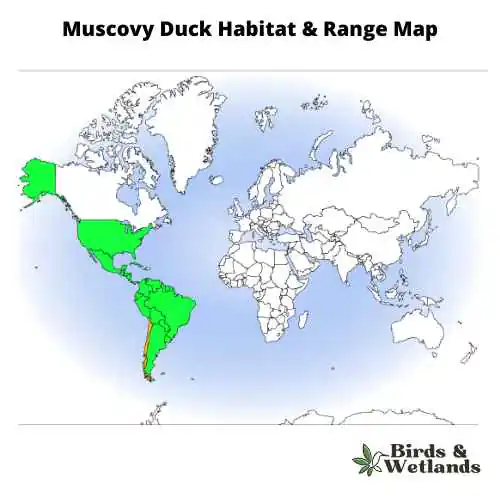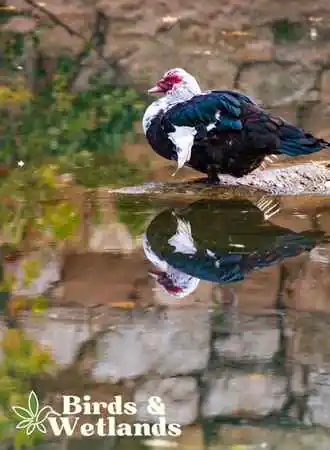The Muscovy duck is a large duck native to Mexico, Central America, and South America. They are also known as Pato Criollo in Spanish. Male Muscovy ducks are easily distinguished from females by their large size and reddish-brown plumage.
The Muscovy duck is an excellent swimmer and can fly short distances. These ducks inhabit park ponds and wetlands, feeding on aquatic plants, insects, fish, and other small animals.
Most domestic ducks except Muscovy ducks originated from Mallard stock.
Although they are not considered a nuisance species, Muscovy ducks can sometimes become aggressive towards humans or other animals. As a result, it is important to exercise caution when around Muscovy ducks and keep them away from small children.
Scientific Name: Cairina moschata
Height: 76 cm (30 in)
Wingspan: 1.4 – 1.5 m
Weight: 7 kg (15 lb)
Muscovy Duck Description
For bird watchers, here’s how to ID Muscovy ducks.
Wild Muscovy Duck
A Muscovy duck has a dark plumage with large white wing patches, dark legs, webbed feet with sharp claws and a broad, flat tail. Their eyes are yellowish-brown.
Males have a short crest on the back of their necks, black bills with pale pink spots and a dark red knob at the bottom. Their black feathers are iridescent in sunlight.
Females have feathers around their faces with no prominent knobs and are smaller than males.
Juvenile Muscovy ducks have a duller appearance, with little white specks on the upper wing.

Domestic Muscovy Duck Appearance
Domestic ducks share similar plumage with their wild counterparts, but some variations of dark brown, black mixed with white and all-white plumage exist.
Faces of both male and female domestic Muscovy ducks are either black-and-red or red. The male Muscovy drake has prominent caruncles at the base of its bill and a low, erectile feather crest.
Listen to Muscovy Duck
The male Muscovy duck occasionally produces a low, breathy huff, not a full quack. Muscovy ducks are generally silent, but males sometimes have a low whistle. In contrast, females produce relatively quiet trilling coo.
Muscovy ducks are not known for being particularly vocal, but they can also make hisses, grunts, and growls, among different sounds. Typically, these vocalizations are only heard when the ducks feel threatened or are agitated.
Muscovy Duck Habitat
Muscovy ducks inhabit numerous habitats, including coastal regions, lowland forests, and wooded habitats near lakes, swamps, marshes, and lagoons. They prefer areas with abundant water and vegetation because it provides them with places to hide from predators and food.

Muscovy Duck Range
Muscovy ducks inhabit various habitats, including wetlands, forests, and agricultural lands in Central and South America. They live in Mexico, Brazil, Argentina, Uruguay, and Venezuela.
These waterfowl have taken up residence in some parts of the southern United States. In Texas, they have inhabited forested areas of the lower Rio Grande Valley. There are feral populations along the Gulf Coast and in Florida.
This tropical bird is non-migratory and typically resides in the same location throughout the year. Although rare, many Muscovy ducks have been seen living near or in urban areas.

Muscovy Duck Diet
Muscovy ducks are omnivores, consuming both plant and animal matter. Their diet consists mostly of grasses, seeds, sedges, tubers, weeds and other aquatic plants. Occasionally, they feed on small animals such as insects, spiders, larvae, worms, mollusks and other aquatic invertebrates.
Muscovy ducks also eat mosquitoes, snails, crayfish, and frogs. Although they are predominantly found in freshwater habitats, they occasionally venture into brackish or salt water in search of food.
Muscovy ducks generally are not picky eaters and will consume any readily available food.
Muscovy Duck Nesting & Mating Habits
Typically, the breeding season for Muscovy ducks occurs during the wet season. However, this can vary depending on the geographical range. For instance, the further north the ducks are found, the earlier in the year they will begin to breed.
Muscovy ducks in North America breed in late April or early May, while those in Central and South America breed between June and July.
The length of the breeding season also varies by location. It typically lasts 3 to 4 months in North America but can last up to 7 months in Central and South America.
Feral Muscovy ducks breed in pairs. They build their nests in holes in the ground or tree cavities. Some Muscovy ducks have been observed to use abandoned raptors’ nests as their own. Other Muscovy ducks also use nest boxes. They prefer to nest in low elevations with thick vegetation.
The female Muscovy duck lays between 8 and 15 greenish-white eggs. The incubation period can take between 30 to 31 days. The female incubates the eggs while the male stands near the nest. Once the eggs hatch, the female usually cares for and looks after the ducklings on her own.
Muscovy ducklings are precocial, meaning they are born with their eyes open. They can fend for themselves early and leave the nest quickly. During the first few weeks, they only depend on their mother for food and shelter at night.
After some time, young ducklings will imitate and learn from their mother how to find food and care for themselves. These young wild birds will eventually attain complete independence and live independently.
Even though Muscovy ducklings are precocial, they still require their mother’s guidance in the early stages of life.

Muscovy Duck Population & Conservation
The Muscovy duck is a species of duck that is native to Central and South America. The current population of Muscovy ducks is estimated to be between 500,000 to 550,000 individuals.
The Muscovy duck’s conservation status is considered “Least Concern” by the International Union for Conservation of Nature (IUCN).
However, the Muscovy duck is hunted in some areas of its range, and its habitat is lost to development. Additionally, hybridization with domestic ducks, which produces a “mule duck” (sterile offspring) threatens the wild population of Muscovy ducks.
Despite these threats, the Muscovy duck is not considered endangered.
Key Points
- The Muscovy duck is a large duck native to Central and South America.
- Muscovy ducks live in wetlands, forests, and agricultural lands.
- Female Muscovy ducks lay between 8 and 15 greenish-white eggs and incubate for 30 to 31 days.
- Muscovy ducks didn’t come from Mallards.
- The conservation status of the Muscovy duck is currently designated as “Least Concern.”
- Muscovy duck eggs are delicious but have a more intense taste than chicken eggs.
- After hatching eggs, the mother duck takes care of the young ducks.
FAQs on Muscovy Ducks
Are Muscovy ducks raised for their meat and eggs?
Like most domesticated ducks, Muscovy ducks are raised for their meat and eggs because they are a healthy option with a high yield. They have a higher meat yield than any other duck, and the meat is 98% fat-free. Muscovy ducks are also less greasy than other ducks and have approximately 50% more breast meat.
Furthermore, Muscovy eggs taste like chicken eggs but tend to be more intense due to the duck’s diet.
What does Muscovy duck’s meat taste like?
The meat of the Muscovy duck, sometimes called the Barbary duck or Turkey duck, have a taste similar to that of roast beef.

Do Muscovy ducks fly away?
Muscovy ducks actually don’t fly very well. They are heavier and bulkier than most other domestic ducks. Because of their large and bulky bodies, they have difficulty getting airborne.
Moreover, their wings are shorter and inefficient compared to other species. Therefore, Muscovies often hover close to the ground, flapping their wings frantically.
Occasionally, they can fly short distances between perches. Generally, these ducks prefer to walk or swim rather than fly.
Are Muscovy ducks friendly to humans?
Muscovy ducks are fascinating animals with distinct behaviors. For instance, they dislike being picked up and held by humans but enjoy spending time with humans. This peculiar behavior makes them ideal pets for families with children, so long as their personal space is respected.
In addition, Muscovy ducks are typically non-aggressive. But they can become protective of their mates and ducklings during mating and rearing season.
Due to their mild temper, Muscovy ducks make excellent companions for people looking for low-maintenance yet friendly birds for their farms.

Do Muscovy ducks perch on trees?
The Muscovy duck is known for its flight capabilities, and it often takes to the air in search of food or new hiding spots. Even though Muscovy ducks enjoy swimming and wading in water, they also enjoy perching in trees. Often, these ducks build their nests high off the ground to take advantage of their improved vantage point.
Muscovy ducks can observe other ducks from a perch and watch out for predators. After dipping their webbed feet in the water, Muscovy ducks perch to rest their feet and dry their feathers.

